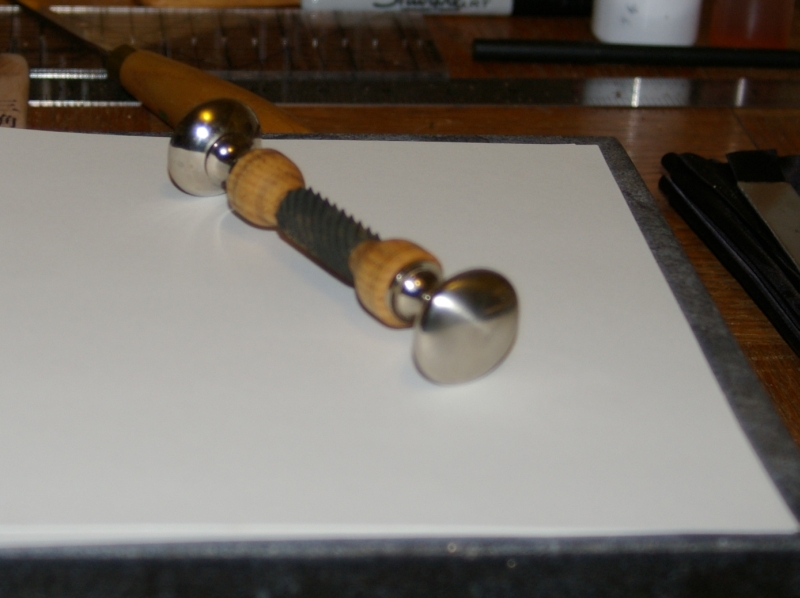I have been wanting one of these for about three years. I finally made one!
This was made from one of the cutters in an old broken pencil sharpener. It was a bit dull so I sharpened the cutter using the ancient method of soaking it in vinegar. Now it is nice and sharp. A bit of all-thread, between the knobs, holds it all together. Great little tool, Kind of a cross between a float, file and a spoke shave.
Bob

 A page Dedicated to My Writing
A page Dedicated to My Writing
Great Pencil Shave!
I love the simplicity and practical idea of it. Can you tell me a little more about the vinegar soaking in order to sharpen? How does it work?
John
Vinegar is an acid that has long been used to clean steel tools and sharpen files and rasps. Since you cannot easily sharpen a a file, having the outermost layer dissolve in vinegar can give a very nice sharp edge. There are several other advantages to sharpening in vinegar.
Vinegar dissolves rust faster than it dissolves steel, so at the same time as sharpening, it helps soften the rust off for removal. Vinegar, as it dissolves steel forms a different kind of rust. Gray instead of red. Red rust expands as it forms, making cracks that encourage further rust. Gray rust is fairly tough, does not expand and creates a protective layer that somewhat resists further rust. A lot of old timers used to soak blades in vinegar to provide a touch of rust resistance.
Typically a file is left over night in vinegar to restore it. In vinegar that has been in the Texas heat, a few hours is good enough. The vinegar cannot be used over and over however, it tends to weaken quickly with use.
Bob
Hello Bob;
Excellent description of the process. I often use vinegar when derusting a vintage tool to get the grey look instead of the blue look of phosphoric acid, and a little bit of protection. Most of the time – when not sharpening a file, and I don’t care about the finished look – I use the phosphor bluing instead to leave a bit more coating on the metal.
Didn’t you have a full article on derusting awhile back????
Skip
I did have this one, http://toolmakingart.com/2008/06/24/rust-prevention/, but it is dated as the first 2 and the last link are now dead.
I probably need to do a new one, as I have had a bit more time to test a few more methods.
I really appreciate well maintained and formed rustic work, so the dull silver grey patina on a knife blade is, to me, quite lovely. On some old kitchen knives, The sort that started out for chopping and are now fillet knives, the varied soft hued splotches are quite charming. The dutiful use and the long care that it takes to wear down such a knife, makes it all the more charming.
Bob
Ah yes, I do think you need to keep one derusting article current on here somewhere…
Myself, I tend towards rehabbing the old woodies because only the blades need derusting, however…
I am about to do a Stanley #3 which has a little bit of value, so I am going with the grey look for it. Usually I go for the extra rust protection here on the gulf coast of phosphor bluing….. Besides, all those Bob Smalser articles on phosphor bluing can’t be wrong???
Take care..
Skip
I have only done bluing on tool steel, so I do not know how well it works with cast iron, malleable or otherwise. Bob Smalser has taught me a lot and I am quite grateful for the great information he has provided so freely. I have not read where he has used it on cast iron however.
Parkerizing is a treatment used on cast iron, and Oxpho Blue is used on cast iron, so the combination should work, but testing it first might be in order. My fear is that the Japanning might be removed. In any case be careful, the Japanning is probably chock full of lead.
I am working on a lead free Japanning formula, but the results need to go through a years aging and weather before I can make any recommendations.
Bob
Mercy! I hadn’t even thought about cast iron! And here I am about to be assessing some jappaning, and what to do about it. It’s too dirty to tell if it’s good or not. I’ve never had a #3 or any other somewhat valuable tool, so I just clean’em and spray’em engine black.
I’ve never used phosphoric acid or vinegar on cast iron…. hmmmnn… like I say, woodies don’t have these problems, except for the blades…….
Thanks for pointing that out!
Skip
Hmmmnnn, on second thought… the body is cast too isn’t it….. and I do brush phosphoric acid on the sides and the sole after flattening’em… but I don’t get any on the jappaning!
That would be a case where soaking in vinegar mite be a bit less work… still it’s easier to do that by giving’em to my son to use his electrolosis outfit on, no work for me at all, and it even builds a little metal back on. All told, I guess I still use vinegar mostly on files….
Skip